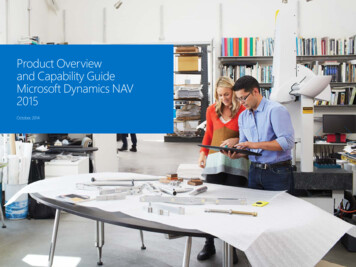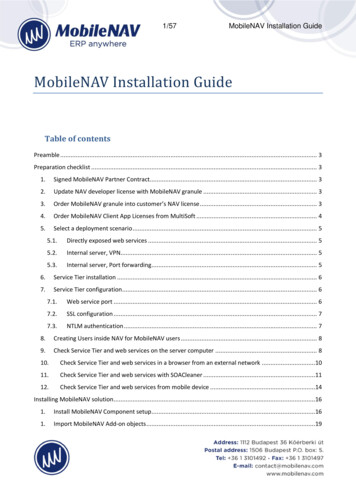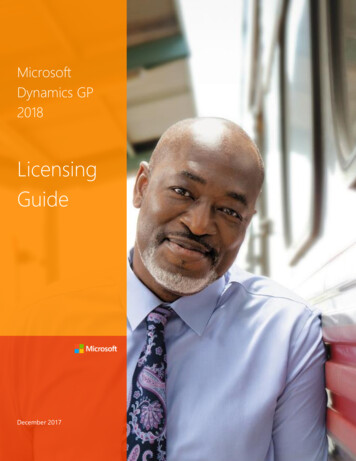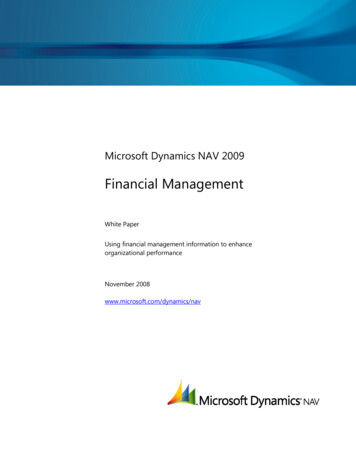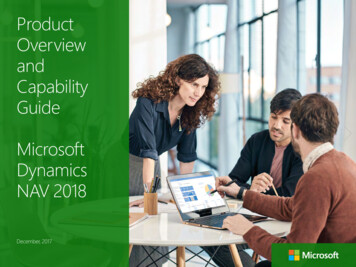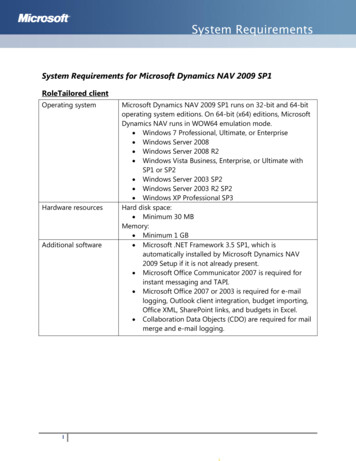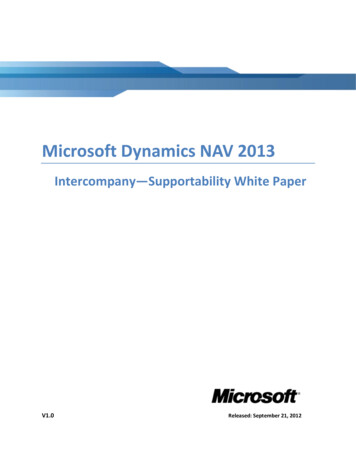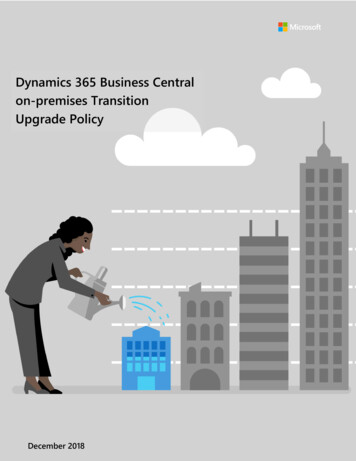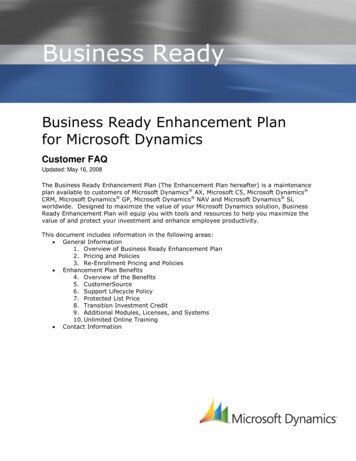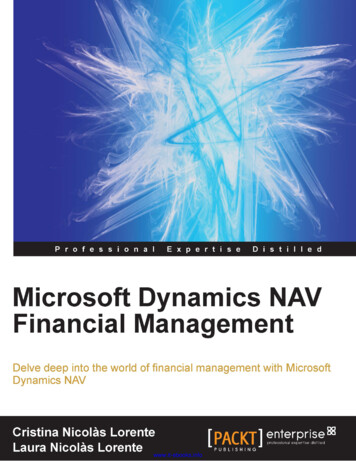
Transcription
www.it-ebooks.info
Microsoft Dynamics NAVFinancial ManagementDelve deep into the world of financial managementwith Microsoft Dynamics NAVCristina Nicolàs LorenteLaura Nicolàs LorenteBIRMINGHAM - MUMBAIwww.it-ebooks.info
Microsoft Dynamics NAV Financial ManagementCopyright 2013 Packt PublishingAll rights reserved. No part of this book may be reproduced, stored in a retrievalsystem, or transmitted in any form or by any means, without the prior writtenpermission of the publisher, except in the case of brief quotations embedded incritical articles or reviews.Every effort has been made in the preparation of this book to ensure the accuracyof the information presented. However, the information contained in this book issold without warranty, either express or implied. Neither the authors, nor PacktPublishing, and its dealers and distributors will be held liable for any damagescaused or alleged to be caused directly or indirectly by this book.Packt Publishing has endeavored to provide trademark information about all of thecompanies and products mentioned in this book by the appropriate use of capitals.However, Packt Publishing cannot guarantee the accuracy of this information.First published: October 2013Production Reference: 1161013Published by Packt Publishing Ltd.Livery Place35 Livery StreetBirmingham B3 2PB, UK.ISBN o
CreditsAuthorsProject CoordinatorCristina Nicolàs LorenteAkash PoojaryLaura Nicolàs LorenteProofreaderLawrence A. HermanReviewersStefano DemilianiIndexerMylia S. RubanzanaHemangini BariAcquisition EditorsGraphicsHarsha BharwaniRonak DhruvAkram HussainCommissioning EditorDeepika SinghTechnical EditorJinesh KampaniProduction CoordinatorKirtee ShinganCover WorkKirtee ShinganCover ImageValentina Dsilvawww.it-ebooks.info
About the AuthorsCristina Nicolàs Lorente has been working with Dynamics NAV since 2005.She started in the ERP world as a developer, but soon evolved to a completeDynamics NAV professional, doing all the tasks involved in Dynamics NAVimplementation: consultancy, analysis, development, implementation, training,and support to end users.When Cristina started developing solutions for Dynamics NAV she had no ideaabout accounting or about any kind of business workflows. They don't teach thosekind of things for a technical university career. Soon she discovered that itis important to know the set of tools used, but even more important to understandthe meaning of whatever you develop. Without knowing the accounting rules,practices, and legal requirements, it is impossible to develop useful accountingfunctionalities even if you are the best developer. Only when you fully understanda company's processes you will be able to do the appropriate developments.Having that in mind, she has taken courses in Accounting, WarehouseManagement, and Operations Management. She is also willing to take courseson any other company related topics.She thinks that the best way to learn is to teach what you are learning to someoneelse. She has actually learned almost everything she knows about Dynamics NAVby responding to user questions on internet forums, by writing a blog aboutDynamics NAV, and of course by writing the book you have in your hands. Whenyou have to write about something, you have to experiment, try, investigate, andread. It is definitely the best way to learn.Cristina is also co-author of the book Implementing Microsoft Dynamics NAV 2013,which had really good comments coming from different Dynamics NAV experts.www.it-ebooks.info
AcknowledgmentsI would like to thank Isabel, who has supported me on this project. She has alwaysbelieved in me and she has been pushing me to find the time invested on this book.Without her, this project would have been much more difficult than it turned out to be.I would also like to thank Laura, my sister and colleague, the coauthor of this book,for being always positive about what you can reach with effort, discipline, andconfidence of your own possibilities. She is the one who encouraged me to writethis book.A special thanks to Josep and Josep Maria. They have given me an opportunityto professionally evolve. They have always believed in me and have given methe needed confidence to take my own steps and responsibilities.The final thanks goes to all my colleagues and customers, and also for all thepeople who helped me to learn by posting questions on the forums. You haveall contributed to build the professional, I am today.www.it-ebooks.info
Laura Nicolàs Lorente started to work with Dynamics NAV back in 2005, firstin the support department, mostly solving functional issues and doubts. She soonjumped to full deployment: consulting, analysis, development, implementation,migration, training, and support.Right from the beginning she realized that it was very important for a DynamicsNAV consultant to have a deep knowledge of business workflows. Technical skillsare just not enough. So she started to train herself accounting, taxation, supplychain, logistics, and so on. She discovered a whole new world and she found itvery interesting.After having enough consultancy experience, she got to manage the first projecton her own. And then she realized that tech and business knowledge is not enough:she also needed management skills. This is why after reading different managementbooks and trying different approaches on the projects she worked on, she decidedto deepen her knowledge by taking a Masters in Project Management. She is nowtransitioning to Agile Management and Agile Development for better project success.She continues her training in the three areas (tech, business workflows, andmanagement) whenever she gets the chance.The net is a huge source of inspiration for her: groups, forums, blogs, books, andso on. She also contributes by sharing her knowledge and experience with theSpanish Dynamics NAV community.Laura is also co-author of the book Implementing Microsoft Dynamics NAV 2013,which had really good comments coming from different Dynamics NAV experts.www.it-ebooks.info
I would like to dedicate this book to Roc and Quim, my twin sons that were bornwhile writing this book. Being a mum has changed me and my life, and I am reallyhappy with it. A new life starts from now on. I hope I will be able to teach themthe values I learned from my parents, that made me be the person I am.I also want to dedicate it to Rosa, my wife, who gave birth to such beautiful babies.She is the pillar onto which I hold, and the person that gives me the energy I needto keep going.I would like to thank Cristina. She is my sister, my friend, and my colleague.We both wrote this book and had a great time together while writing and learning.I wish us many successful projects together, now and in the future.Also thanks to my family, friends, colleagues, managers, and customers whohelped me grow. And a special recognition to my forum and blog followers fortheir comments. It is nice to know that you are helping people and that they thankyou for that.www.it-ebooks.info
About the ReviewersStefano Demiliani is a Microsoft Certified Solution Developer, MCTS on MicrosoftDynamics NAV, and MCTS on Sharepoint, and different .NET technologies.He has a Masters degree in Computer Engineering from Politecnico of Turin.He works as a Senior Project Manager and Solution Developer for EID/Navlab(one of the biggest Microsoft Certified Partners in Italy) and his main activityis architecturing and developing solutions based on Microsoft technologies.He has written many articles and blogs on different Microsoft related topics(.NET, Sharepoint, Microsoft Dynamics) and he's frequently involved in consultingon these topics.You can get more details and keep in touch with him by reaching the sitehttp://www.demiliani.com or via Twitter (@demiliani).www.it-ebooks.info
Mylia S. Rubanzana (MBA, MABR, PGDFM, BCOM, and DIP) is currentlya Finance Manager at Uganda National Council for Science and Technology. Myliahas over 20 years of working experience specializing in financial management. Myliais a Member of the International Consortium on Governmental Financial Managementand a Council Member of Uganda Technology and Management University.In 2011, he proposed an implementation plan for the Science, Technology, andInnovation Fund. He worked on System Financing in the Science, Technologyand Innovation benchmarking study of Finland. Also, he performed an assessmentof the budget performance management in the public sector the Uganda: a casestudy of Uganda National Council for Science and Technology. He established theChina-Uganda Scientific and Cultural Village in Uganda. In 2010, he participatedin transfer and commercialization of charcoal manufacturing technology for farmersand entrepreneurs in Uganda. In 2005, he worked on Accounting information systemand quality of financial reporting at some Public institutions in Uganda: Case studyof Uganda National Council for Science and Technology. Later, he worked ona financial procedural manual for Science and Technology. In 2002, he workedon Financial procedural Manual for the National Civic Education Program. In 1990,he wrote an extended essay on Gold Trust Bank.www.it-ebooks.info
www.PacktPub.comSupport files, eBooks, discount offers and moreYou might want to visit www.PacktPub.com for support files and downloads relatedto your book.Did you know that Packt offers eBook versions of every book published, with PDFand ePub files available? You can upgrade to the eBook version at www.PacktPub.com and as a print book customer, you are entitled to a discount on the eBook copy.Get in touch with us at service@packtpub.com for more details.At www.PacktPub.com, you can also read a collection of free technical articles, signup for a range of free newsletters and receive exclusive discounts and offers on Packtbooks and eBooks.TMhttp://PacktLib.PacktPub.comDo you need instant solutions to your IT questions? PacktLib is Packt's online digital booklibrary. Here, you can access, read and search across Packt's entire library of books.Why Subscribe? Fully searchable across every book published by PacktCopy and paste, print and bookmark contentOn demand and accessible via web browserFree Access for Packt account holdersIf you have an account with Packt at www.PacktPub.com, you can use this to accessPacktLib today and view nine entirely free books. Simply use your login credentialsfor immediate access.Instant Updates on New Packt BooksGet notified! Find out when new books are published by following @PacktEnterpriseon Twitter, or the Packt Enterprise Facebook page.www.it-ebooks.info
Table of ContentsPrefaceChapter 1: The Sales and Purchase ProcessIntroducing Microsoft Dynamics NAVImportance of Financial ManagementPosted data cannot be modified (or deleted)No save buttonUnderstanding master dataCustomersItemsVendors, resources, and locationsPricingDefining sales pricesDefining sales discountsPurchase pricingDocumentsDocument workflowsDocument approvalSummaryChapter 2: Managing Payments and BanksManaging due datesPayment termsPrepaymentsUsing credit cards and other payment methodsPosting paymentsSuggesting vendor paymentsCreating and printing 32829303131323333343636
Table of ContentsChecking customer and vendor balancesWhich invoice has been paid?Bank reconciliationSummaryChapter 3: Accounting ProcessesPosting accounting transactionsStandard journalsRecurring journalsAllocations373838404141434445Reporting taxes – VATVAT SettlementVAT StatementsManaging fixed assetsCreating a fixed asset and posting its acquisition costRevaluating fixed assetsCalculating depreciationSelling or disposing a fixed assetCanceling fixed asset entriesInventory valuationChoosing a costing methodCalculating item entries costs464749505052535455555656Posting inventory valuation to the general ledgerInventory valuation reportClosing the accounting yearClosing accounting periodsRunning the Close Income Statement batch processRestricting the allowed posting datesPosting transactions on a closed yearConsolidating financial statementsPerforming consolidation575859606062626263Inbound entriesOutbound entriesConsolidating on single databaseConsolidating with different databasesConsolidating with other applicationsReporting over a consolidated companySetting it upDefining business unitsTranslating a chart of accountsSummary56576364656666676868[ ii ]www.it-ebooks.info
Table of ContentsChapter 4: Reporting and Business IntelligenceUnderstanding dimensionsDefining default dimensions on master dataUsing dimensions on documents and journalsUsing filters and flowfiltersApplying filters on pagesApplying flowfilters on pagesCreating viewsUsing reportsDisplaying chartsShow as a chart optionAdding charts to the role center pageUsing account schedulesAnalysis viewsCreating analysis viewsUsing analysis viewsAnalysis by dimensionsAnalysis views as a source for account schedulesBusiness Intelligence with Excel and 1828385Chapter 5: Foretelling – Budgeting and Cash Flow Management87Chapter 6: Financial Management Setup99BudgetsCreating budgetsUsing budgetsCash flow managementCreating manual expenses and revenuesCash flow management setupSummaryUnderstanding posting groupsSpecific posting groupsGeneral posting groupsVAT posting groupsSetting up dimensionsNumber seriesGeneral setupSummary[ iii 105107
Table of ContentsChapter 7: Other Financial Functionalities109Index113CurrenciesIntercompany postingsAccounting implications of other areasJobsServiceWarehouseManufacturingXBRLSummary[ iv ]www.it-ebooks.info109110111111111111112112112
PrefaceDynamics NAV is an Enterprise Resource Planning (ERP) system targeted at smalland medium-sized companies. An ERP is a system, a software, which integrates theinternal and external management information across an entire organization. If yousearch the net you will find plenty of documentation, webs, forums, and all kindsof information covering Dynamics NAV from many technical points of view. Butyou will find nothing or little covering Dynamics NAV from a functional point ofview, meant for end users. Thousands of users from all around the world that useDynamics NAV as their main tool for daily work complain that they cannot findinformation about what they need from the system. And they are right.This book is written for them, after the experience of giving training to many endusers in each implementation we have worked on. We have found out that mostusers do not care about system configuration; they just want to know how the systemworks. They contact Dynamics NAV consultants to set up when needed. But in thelittle end user documentation found, each topic starts with a full setup introductionthat confuses readers and may even discourage them from reading further.In this book we have changed the established structure of official manuals. Insteadwe have used a logical structure that makes it easy to read and very easy tounderstand. This is how we teach Dynamics NAV in our training sessions and thisis how people tell us they have learned and understood the application.Don't think this book is only meant for financers and accountants. This book is alsomeant for Dynamics NAV consultants and developers. You need full DynamicsNAV functional knowledge to become an expert, and this book can help you with it.You will never stop learning about new features and functionalities. The idea behindthe book is that you learn enough to be able to keep learning on your own. Everysingle field in every single table can hide a mini functionality that is there to helpyou with your work.www.it-ebooks.info
PrefaceWhat this book coversChapter 1, The Sales and Purchase Process, explains how these two essential businessareas in all companies can be handled in Dynamics NAV. It also shows howDynamics NAV translates all the transactions to accountancy language on the fly.In this chapter, you will learn how to create new customers and vendors, to set upyour pricing policies, and the documents used when selling and purchasing as wellas their workflows.Chapter 2, Managing Payments and Banks, discusses that after invoicing companieshave to charge for the items delivered and have to pay for the services received.In this chapter you will learn how to manage different payment terms and methods,and to analyze customer and vendor extracts and their outstanding balances.To check that the statements your bank provides you agree with the payments andcharges you have posted into the system, you can use the Bank reconciliation featurethat is explained in the chapter.Chapter 3, Accounting Processes, explains how to handle accounting tasks suchas reporting taxes, fixed asset management, inventory valuation, posting payrollaccrual entries, provisions, and other accounting transactions, annual accountingclose, and consolidation with other companies.Chapter 4, Reporting and Business Intelligence, discusses the tools that can help youwith analysis, both inside and outside the application. The previous chapters teachreaders about the data entry and data process tasks. Once the datais introduced into the system, you should be able to analyze it.In this chapter we explain how dimensions can be used to tag entries so that you cangroup entries with similar characteristics. This will allow you to report on the datain a way that is meaningful to the company.Dynamics NAV has a bunch of reports that can be used out of the box. AccountSchedules and Analysis Views are features that allow users to create their ownreports. You can also use the Business Intelligence tools included in Excel by linkingit with your Dynamics NAV database.Chapter 5, Foretelling – Budgeting and Cash Flow Management, discusses thataccounting rules are based on faits accompli, but companies need to anticipate andpredict events. In Dynamics NAV budgets are used to plan costs, revenues, andresources and can be used to set up goals and measure performance. The cash flowmanagement functionality is meant to help companies to predict future cash needs.[2]www.it-ebooks.info
PrefaceChapter 6, Financial Management Setup, explains that in Dynamics NAV everythingleads to accounting, but most of the operations inside Financial Management can becarried out with little accountancy knowledge. You need to set up the system so thatit can translate transactions to accountancy language according to your company rules.In this chapter we cover the general setup, the dimensions setup, the creationand configuration of posting groups, and the definition of number series.Chapter 7, Other Financial Functionalities, explains briefly about currencies,intercompany postings, XBRL, and accounting implications on areas such as Jobs,Services, Warehouse, or Manufacturing. In the previous chapters we have coveredthe most important aspects of financial management with Dynamics NAV. But theapplication has a lot more possibilities.What you need for this bookTo successfully follow the examples in this book you will need an installationof Microsoft Dynamics NAV 2013.Who this book is forThis book is meant for financers and accountants that are using or going to useDynamics NAV as their ERP and financial management system.It is also meant for Dynamics NAV consultants and project managers who will helporganizations to use the system for their daily work.The book will also be very helpful to Dynamics NAV developers who want tounderstand how the standard application is used in organizations, to help themdevelop better features, and more integration with the existing ones.ConventionsIn this book, you will find a number of styles of text that distinguish betweendifferent kinds of information. Here are some examples of these styles, and anexplanation of their meaning.[3]www.it-ebooks.info
PrefaceNew terms and important words are shown in bold. Words that you see on thescreen, in menus or dialog boxes for example, appear in the text like this: "clickon the View icon found on the Home tab of the ribbon."Warnings or important notes appear in a box like this.Tips and tricks appear like this.Reader feedbackFeedback from our readers is always welcome. Let us know what you think aboutthis book—what you liked or may have disliked. Reader feedback is important forus to develop titles that you really get the most out of.To send us general feedback, simply send an e-mail to feedback@packtpub.com,and mention the book title via the subject of your message. If there is a topic that youhave expertise in and you are interested in either writing or contributing to a book,see our author guide on www.packtpub.com/authors.Customer supportNow that you are the proud owner of a Packt book, we have a number of thingsto help you to get the most from your purchase.ErrataAlthough we have taken every care to ensure the accuracy of our content, mistakes dohappen. If you find a mistake in one of our books—maybe a mistake in the text or thecode—we would be grateful if you would report this to us. By doing so, you can saveother readers from frustration and help us improve subsequent versions of this book.If you find any errata, please report them by visiting http://www.packtpub.com/submit-errata, selecting your book, clicking on the errata submission form link,and entering the details of your errata. Once your errata are verified, your submissionwill be accepted and the errata will be uploaded on our website, or added to any listof existing errata, under the Errata section of that title. Any existing errata canbe viewed by selecting your title from nfo
PrefacePiracyPiracy of copyright material on the Internet is an ongoing problem across all media.At Packt, we take the protection of our copyright and licenses very seriously. If youcome across any illegal copies of our works, in any form, on the Internet, pleaseprovide us with the location address or website name immediately so that we canpursue a remedy.Please contact us at copyright@packtpub.com with a link to the suspectedpirated material.We appreciate your help in protecting our authors, and our ability to bring youvaluable content.QuestionsYou can contact us at questions@packtpub.com if you are having a problemwith any aspect of the book, and we will do our best to address it.[5]www.it-ebooks.info
www.it-ebooks.info
The Sales and PurchaseProcessSales and purchases are two essential business areas in all companies. In manyorganizations, the salesperson or the purchase department are the ones responsiblefor generating quotes and orders. People from the finance area are the ones in chargeof finalizing the sales and purchase processes by issuing the documents that havean accountant reflection: invoices and credit memos.In the past, most systems required someone to translate all the transactions toaccountancy language, so they needed a financer to do the job. In Dynamics NAV,anyone can issue an invoice, with zero accountant knowledge needed. But a lot ofcompanies keep their old division of labor between departments. This is why we havedecided to explain the sales and purchase processes in this book. This chapter explainshow their workflows are managed in Dynamics NAV. In this chapter you will learn: What Dynamics NAV is and what it can offer to your company To define the master data needed to sell and purchase How to set up your pricing policies What kind of documents you can issue The workflows inside the sales and purchases areawww.it-ebooks.info
The Sales and Purchase ProcessIntroducing Microsoft Dynamics NAVDynamics NAV is an Enterprise Resource Planning (ERP) system targeted at smalland medium-sized companies.An ERP is a system, a software, which integrates the internal and externalmanagement information across an entire organization. The purpose of an ERPis to facilitate the flow of information between all business functions insidethe boundaries of the organizations. An ERP system is meant to handle all theorganization areas on a single software system. This way the output of an areacan be used as an input of another area.Dynamics NAV 2013 covers the following functional areas: Financial Management: This includes accounting, G/L budgets, accountschedules, financial reporting, cash management, receivables and payables,fixed assets, VAT reporting, intercompany transactions, cost accounting,consolidation, multicurrency, and intrastat. Sales & Marketing: This area covers customers, order processing, pricing,contacts, marketing campaigns, and so on. Purchase: The purchase area includes vendors, order processing, approvals,planning, costing, and other such areas. Warehouse: Under the warehouse area you will find inventory, shippingand receiving, locations, picking, assembly, and so on. Manufacturing: This area includes product design, capacities, planning,execution, costing, subcontracting, and so on. Job: Within the job area you can create projects, phases and tasks, planning,time sheets, work in process, and other such areas. Resource Planning: Manage resources, capacity, and so on. Service: Within this area you can manage service items, contracts, orderprocessing, planning and dispatching, service tasks, and so on. Human Resources: Manage employees, absences, and so on.Some of these areas will be covered in detail in this book.Dynamics NAV offers much more than robust financial and business managementfunctionalities. It is also a perfect platform to customize the solution to truly fit yourcompany needs. If you have studied different ERP solutions, you know by nowcustomizations to fit your specific needs will always be necessary. Dynamics NAVhas a reputation for being easy to customize, which is a distinct advantage.[8]www.it-ebooks.info
Chapter 1Since you will probably have customizations in your system, you might find somedifferences with what is explained in this book. Your customizations could imply that: You have more functionality in your implementation Some steps are automated, so some manual work can be avoided Some features behave differently than explained here There are new functional areas in your Dynamics NAVIn addition Dynamics NAV has around forty different country localizations thatare meant to cover country-specific legal requirements or common practices.Many people and companies have already developed solutions on top of DynamicsNAV to cover horizontal or industry-specific needs, and they have registered theirsolution as an add-on, such as: Solutions for the retail industry or the food and beverages industry Electronic Data Interchange (EDI) Quality or maintenance management Integration with third-party applications such as electronic shops, datawarehouse solutions, or CRM systemsThose are just a few examples. You can find almost 2,000 registered third-partysolutions that cover all kind of functional areas. If you feel that Dynamics NAV doesnot cover your needs and you will need too much customization, the best solutionwill probably be to look for an existing add-on and implement it along with yourDynamics NAV.Anyway, with or without an add-on, we said that you will probably needcustomizations. How many customizations can you expect? This is hard to tellas each case is particular, but we'll try to give you some highlights.If your ERP system covers 100 percent of your needs without any customization,you should worry. This means that your procedures are so standard that there is nodifference between you and your competitors. You are not offering any special serviceto your customers, so they are only going to measure you by the price they are getting.On the other hand if your Dynamics NAV only covers a low percentage of yourneeds it could just mean two things: this is not the product you need; or yourorganization is too chaotic and you should re-think your processes to standardizethem a bit.Some people agree that the ideal scenario would be to get about 70-80 percentof your needs covered out of the box, and about 20-30 percent customizationsto cover those needs that make you different from your competitors.[9]www.it-ebooks.info
The Sales and Purchase ProcessImportance of Financial ManagementIn order to use Dynamics NAV, all organizations have to use the FinancialManagement area. It is the epicenter of the whole application. All other areas areoptional and their usage depends on the organization's needs. The sales and thepurchase areas are also used in almost any Dynamics NAV implementation.Actually, accountancy is the epicenter, and the general ledger is included insidethe Financial Management area. In Dynamics NAV everything leads to accounting.It makes sense as accountancy is the act of recording, classifying, and summarizing,in terms of money, the transactions and events that take place in the company.Every time the warehouse guy ships an item, or the payment department ordersa transfer, these actions can be written in terms of money using accounts, credit,and debit amounts.An accountant could collect all the company transactions and translate them one-byone to accountancy language. But this means manual duplicate work, a lot of chancesof getting errors and inconsistencies, and no real-time data.On the other hand, Dynamics NAV is capable to interpret such transactions andtranslate them to accountancy on the fly. In Dynamics NAV everything leadsto accountancy, so all the company's employees are helping the financial departmentwith their job. The financers can now focus on analyzing the data and takingdecisions, and they don't have to bother on entering the data anymore.Posted data cannot be modified (or deleted)One of the first things you will face when working with Dynamics NAV is theinability to modify what has been posted, whether it's a sales invoice, a shipmentdocument, a general le
Cristina Nicolàs Lorente has been working with Dynamics NAV since 2005. She started in the ERP world as a developer, but soon evolved to a complete Dynamics NAV professional, doing all the tasks involved in Dynamics NAV implementation: consultancy, analysis, development, implementation, training, and support to end users.
